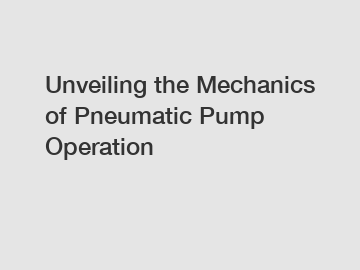Unveiling the Mechanics of Pneumatic Pump Operation
If you work in an industry that relies on pneumatic pumps, understanding how they operate is crucial to maximizing their performance and efficiency. These powerful machines utilize compressed air to move fluids, making them an essential component in a wide range of applications, from industrial manufacturing to agriculture.
To truly grasp the mechanics of pneumatic pump operation, it's essential to first understand how they utilize compressed air to generate the force needed to move fluids. Pneumatic pumps work on the principle of displacement, where a volume of air is compressed within the pump cylinder, creating pressure that forces the fluid to move through the system.
One of the key components of a pneumatic pump is the pneumatic cylinder, which contains a piston that moves back and forth within the cylinder. As compressed air is introduced into the cylinder, it pushes the piston in one direction, creating a vacuum that draws fluid into the cylinder. As the piston moves back in the opposite direction, the fluid is pushed out of the cylinder and through the system.

Another important component of a pneumatic pump is the check valve, which helps to regulate the flow of fluid through the system. The check valve ensures that fluid can only flow in one direction, preventing backflow and maintaining the efficiency of the pump.
In addition to the basic components of a pneumatic pump, there are also a variety of other factors that can impact the performance of the system. For example, the size and design of the pump cylinder can affect the amount of force that the pump can generate, as well as the speed at which it can move fluids through the system.
Furthermore, the pressure of the compressed air being used to power the pump can also impact its performance. Higher levels of air pressure can increase the force generated by the pump, allowing it to move fluids more quickly and efficiently. However, it's important to ensure that the pump is not being over pressurized, as this can lead to damage and reduced efficiency.
To ensure that a pneumatic pump is operating at its optimal level, regular maintenance and inspection are essential. This includes checking for any leaks or blockages in the system, as well as ensuring that all components are properly lubricated and functioning correctly.
In conclusion, understanding the mechanics of pneumatic pump operation is crucial for anyone working in an industry that relies on these powerful machines. By knowing how these pumps work and the factors that can impact their performance, you can ensure that your system is running at maximum efficiency and can meet the demands of your application. So next time you see a pneumatic pump in action, take a moment to appreciate the complex mechanics at work behind its operation.
The company is the world’s best piston pump operation, electric diaphragm pumps for sale, diaphragm pump problems supplier. We are your one-stop shop for all needs. Our staff are highly-specialized and will help you find the product you need.

Comments
0